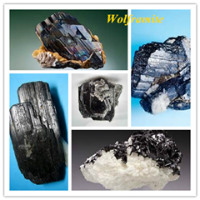- Classification of tungsten ores
- Tungsten does not occur naturally in its pure metallic state; rather, it is found in several ores, but only two kinds of tungsten-bearing mineral rocks, called wolframite and scheelite, are mined commercially. Wolframite accounts for about 70% of the total tungsten resources in the world, and scheelite accounts for about 30%.
 Wolframite is not scientifically classified as an individual mineral species by the International Mineralogical Association (IMA). However, it is widely recognized as a mineral series, with the minerals huebnerite and ferberite being its end members. Huebnerite is the manganese rich end member while ferberite is the iron rich end member. Wolframite is a reddish-brown to grayish-black lustrous mineral which is the chief ore of the metal tungsten.
Wolframite is not scientifically classified as an individual mineral species by the International Mineralogical Association (IMA). However, it is widely recognized as a mineral series, with the minerals huebnerite and ferberite being its end members. Huebnerite is the manganese rich end member while ferberite is the iron rich end member. Wolframite is a reddish-brown to grayish-black lustrous mineral which is the chief ore of the metal tungsten.- Wolframite mainly occurs in quartz veins and pegmatites associated with granitic intrusive rock. Notable occurrences include the Nanling Range, China; southwestern states and Colorado in the USA; Russia; Korea; England; Bolivia; Portugal; Australia; Myanmar and the Malay Peninsula. Wolframite ore can be concentrated by gravity (spirals, cones, tables), sometimes in combination with magnetic separation.
- Because Wolframite is a strong and quite dense material with a high melting temperature, it is an ideal material for electric filaments and armor-piercing ammunition, as well as hard tungsten carbide machine tools.
 Scheelite is a calcium tungstate mineral that forms a series with the rarer mineral powellite, which contains molybdenum in place of the tungsten. Colors include golden yellow, brownish green to dark brown, pinkish to reddish gray, orange and colorless. Transparency ranges from translucent to transparent and crystal faces are highly lustrous. Its gravity is high and its hardness is low. It also fluoresces under shortwave ultraviolet.
Scheelite is a calcium tungstate mineral that forms a series with the rarer mineral powellite, which contains molybdenum in place of the tungsten. Colors include golden yellow, brownish green to dark brown, pinkish to reddish gray, orange and colorless. Transparency ranges from translucent to transparent and crystal faces are highly lustrous. Its gravity is high and its hardness is low. It also fluoresces under shortwave ultraviolet.- Scheelite occurs in contact metamorphic skarns, in high-temperature hydrothermal veins and greisens, and less commonly in granite pegmatites. Notable occurrences include Hollinger Mine, Ontario, Canada; Saxony, Germany; Tong Wha, Korea; Sonora, Mexico; Cornwall, England; New South Wales and Queensland, Australia; Mill City, Nevada, Atolia, San Bernardino Co., California, Cochise Co., Arizona, Utah and Colorado, all in the USA; and Jiangxi, Hunan and Yunnan provinces, China.
- Scheelite is a subordinate ore of tungsten, with wolframite supplying a greater quantity on a worldwide basis. Scheelite is synthesized via the Czochralski process to produce the material that is used to imitate diamond, as a scintillator, or as a solid state lasing medium.
-
About us
Contact us
Make a suggestion
- Metalpedia is a non-profit website, aiming to broaden metal knowledge and provide extensive reference database to users. It provides users reliable information and knowledge to the greatest extent. If there is any copyright violation, please notify us through our contact details to delete such infringement content promptly.
 Wolframite is not scientifically classified as an individual mineral species by the International Mineralogical Association (IMA). However, it is widely recognized as a mineral series, with the minerals huebnerite and ferberite being its end members. Huebnerite is the manganese rich end member while ferberite is the iron rich end member. Wolframite is a reddish-brown to grayish-black lustrous mineral which is the chief ore of the metal tungsten.
Wolframite is not scientifically classified as an individual mineral species by the International Mineralogical Association (IMA). However, it is widely recognized as a mineral series, with the minerals huebnerite and ferberite being its end members. Huebnerite is the manganese rich end member while ferberite is the iron rich end member. Wolframite is a reddish-brown to grayish-black lustrous mineral which is the chief ore of the metal tungsten. Scheelite is a calcium tungstate mineral that forms a series with the rarer mineral powellite, which contains molybdenum in place of the tungsten. Colors include golden yellow, brownish green to dark brown, pinkish to reddish gray, orange and colorless. Transparency ranges from translucent to transparent and crystal faces are highly lustrous. Its gravity is high and its hardness is low. It also fluoresces under shortwave ultraviolet.
Scheelite is a calcium tungstate mineral that forms a series with the rarer mineral powellite, which contains molybdenum in place of the tungsten. Colors include golden yellow, brownish green to dark brown, pinkish to reddish gray, orange and colorless. Transparency ranges from translucent to transparent and crystal faces are highly lustrous. Its gravity is high and its hardness is low. It also fluoresces under shortwave ultraviolet.